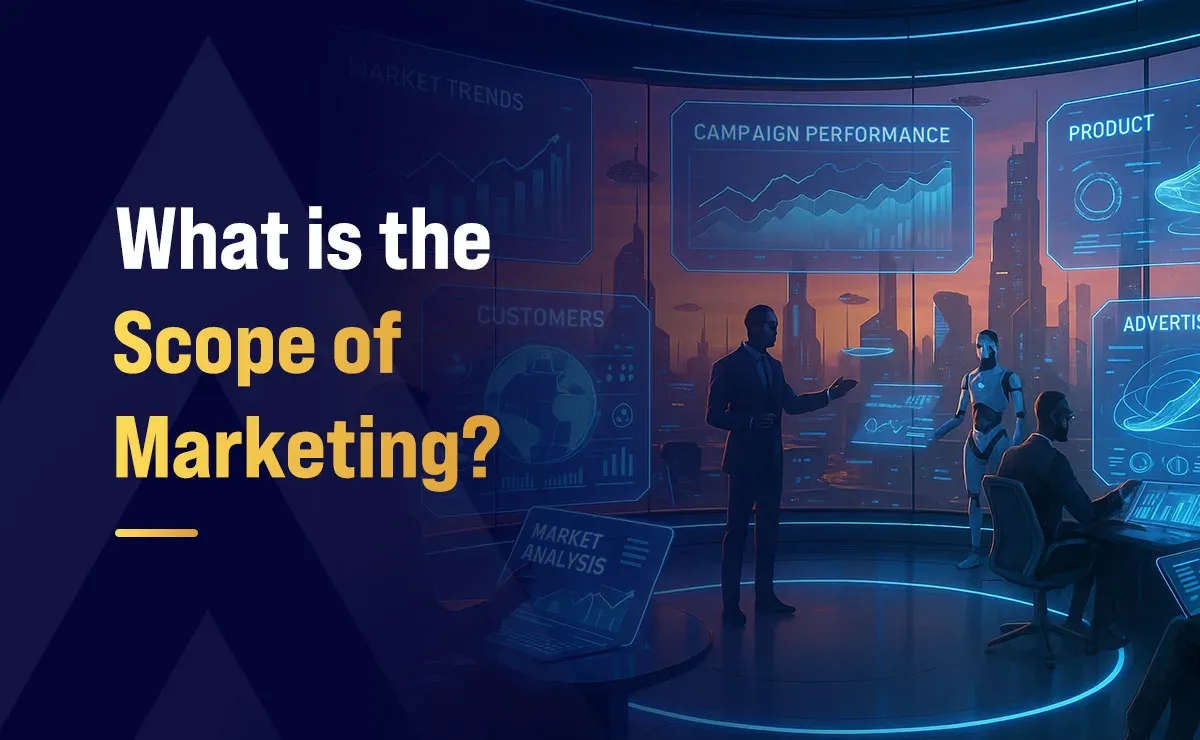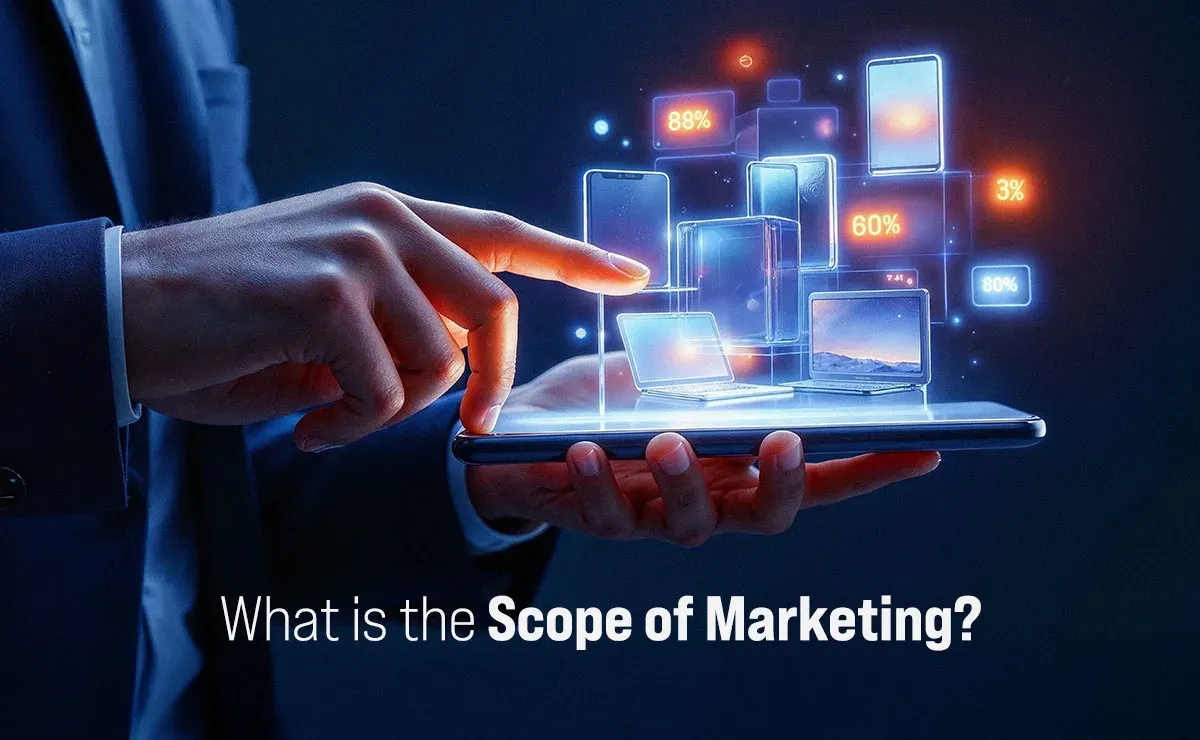What is the Scope of Marketing?

Marketing is one of the pillars of the modern business environment, as it affects not only the level of product visibility, but also customer loyalty and sales increase. Its importance has multiplied manifold in the present environment, where businesses are adopting new technological tools and undergoing a digital revolution.
Marketing today cannot be reduced to conventional approaches, but is a constantly evolving discipline based on data, technology, and customer preferences. We will examine the broad dimensions of marketing, including its definition, relevance, future trends, and the career opportunities it offers.
Understanding marketing opens up countless opportunities. At Altera Institute, students learn practical strategies and develop the confidence to implement them effectively, preparing for success in the dynamic marketing world. Explore how our PGP programs can boost your career.
What is Marketing?
Marketing can be understood as a wide business activity whose objective is to know the needs of consumers and provide products or services that fulfill those needs. Marketing is not about specific sales strategies, but rather about establishing relationships that foster a sense of connection between a company and its clients, trust, and interaction that transcends transactions.
There are three primary stakeholders involved in marketing:
- Product: Creation of product desirability.
- Customers: Knowing their needs and providing value to them.
- Location: Deciding where products will be sold, particularly online.
While advertising is an important part of marketing, the field is much broader, spanning from long before a product is launched to long after a sale is made. It is one of the most sought-after career paths in modern business, with approximately 60% of graduating business school students choosing marketing as their specialization.

The Role of Marketing in Business
Marketing is an inseparable part of contemporary business, impacting the way companies communicate with customers, sit in a competitive market, and pursue sustainable growth. We will discuss the various roles of marketing in achieving business success.
Understanding Customers
Successful marketing begins with a clear understanding of the customer. Through market research, customer surveys, and data analysis on the target audience, companies are able to discover important insights into consumer behavior, preferences, and challenges. This knowledge can enable firms to:
- Identify Customer Needs: Customize products or services to suit the changing needs of consumers, offering a truly value-based service.
- Segmenting audiences: Group customers based on demographics, behaviors, or psychographics to deliver tailored experiences.
- Build Relationships: This involves developing loyalty and trust by responding to the specific needs and expectations of customers.
Brand Building
In a modern competitive business environment, brand personality is a crucial differentiator that companies can use to distinguish themselves from their competitors. Marketing is essential in the development and sustenance of a brand:
- Identity: Building a unique identity for the brand and positioning it well in the market.
- Branding: Being able to have similar messaging and similar visuals across platforms will create familiarity and foster trust.
- Perception: Shaping how customers perceive the brand by telling stories, campaigning, and providing experiences with customers.
Marketing helps a business establish a niche in the market through branding, making the business more memorable to consumers.
Revenue Growth
Marketing initiatives are closely tied to a company's financial performance. In making first sales and securing repeat business, marketing efforts are essential for:
- Customer Acquisition: Acquisition of new customers by use of a value proposition and targeted marketing campaigns.
- Customer loyalty: Driving repeat purchases through loyalty programs and personalized communication strategies.
- Upselling and Cross-Selling: Offering additional or complementary products that enhance customer satisfaction and increase revenue.
A well-executed marketing strategy leads to revenue generation and contributes to long-term profitability.
Driving Innovation
Marketing involves not only responding to customer needs but also predicting these needs. Through customer feedback, strategies of their competitors, and industry analysis, marketing professionals are instrumental in:
- Product Development: To give insights that will inform the development of innovative products or services.
- Improving Customer Experience: Determining how customer experience can be refined to help achieve higher levels of satisfaction.
- Innovating New Strategies: Trying new platforms, technologies, or approaches to keep up with competition in the market.
By nurturing a culture of innovation, marketing ensures businesses stay relevant and adaptable to shifting market trends.
The Nature of Marketing
People often confuse marketing with sales, advertising, and social media, although marketing encompasses all the above aspects and more. A significant part of its value lies in creating, communicating, and delivering offerings that provide value to its customers.
Marketing also controls the major business elements, product, price, place, and promotion to fulfill customer needs and expectations. Marketing professionals are directly responsible for driving revenue and growth by combining creativity and analytical thinking.
As the digital landscape in India continues to evolve, with 751.5 million internet users and 1.12 billion mobile connections, marketing has inevitably adopted a digital-first approach as a strategy.
The shift has harmoniously merged the traditional business models with digital capability and has forced experts to acquire skills in both traditional and digital-first skills. The complexity of marketing turns it into a dynamic field in which practitioners must constantly upgrade their skills and adopt new knowledge.
Lastly, modern marketing is also deeply intertwined with three key stakeholders: the product, the customers, and the place of sale. It involves creating product desirability, identifying customer needs, and determining the appropriate channels through which the product will be distributed, especially online.
The Scope of Marketing with Examples

Marketing is peculiar and expensive, especially in the digital era. It involves both offline and online elements, including optimization of product portfolios and pricing, merchandising, online platforms, brand building, and customer experience across various mediums.
Even though the traditional marketing operates within the BFSI (Banking, Financial Services, and Insurance), IT/ITeS, and FMCG segments are still pronounced, their scope has increased significantly to incorporate the digital-first functionality. Other elements of modern marketing are:
- Digital Brand Management: Firms require specialists with the ability to manage their online brand image effectively and develop digital-first approaches.
- E-commerce: Marketing now heavily involves optimizing online shopping experiences, analyzing user behavior, and implementing conversion strategies to drive sales through digital platforms.
- Category Management: This involves studying market trends, consumer behavior, and competitive environments to optimize product portfolios and develop effective pricing and merchandising strategies.
- Cross-functional Integration: Marketing is no longer isolated; it involves professionals capable of operating on both traditional and digital platforms and knowing the FMCG/BFSI industries and the new digital platforms.
- Data-Centric Strategy Development: Modern-day marketers use an in-depth study of consumer trends and industry changes to create effective campaigns.
Both digitally native companies (such as Blinkit and Zepto) and digitally accelerating companies (such as HUL, Nestle, and Tata Consumer) are working to develop their digital capacities. This transition indicates how marketing has changed, with contemporary marketing integrating both new and old marketing concepts.
Having known the scope of marketing, now we shall see its different significance.
The Importance of Marketing
Marketing has become an essential part of the business in the present day because of its significant influence on:
Strategic Business Growth
- Identifying Growth Opportunities: Marketing plays a crucial role in driving business expansion by identifying and capitalizing on new opportunities.
- Transition to Digital Channels: This helps companies transition from traditional to digital channels, which is essential for survival in today's market.
- Customizing Growth Channels: This allows businesses to develop unique growth channels, as exemplified by traditional businesses such as HUL and Nestle, which are building their own digital ecosystems on top of their existing businesses.
Customer Understanding and Engagement
Marketing helps bridge the gap between businesses and their consumers, as companies can learn more about their target audiences and tailor their messaging to meet their specific needs.
- Insights into consumer behavior: Marketing provides deep insights into customer behavior patterns and trends within the industry, resulting from research and data analysis. Such insights lead to product development, improvement of their services, and customer experience.
- Building Meaningful Connections: Marketing enables businesses to establish meaningful connections with customers across both traditional and digital touchpoints.
- Personalization at Scale: With the integration of AI and big data, marketing enables businesses to deliver highly personalized campaigns and solutions.
Revenue Generation and Business Success
The primary objective of marketing is to drive revenue and ensure sustainable business success. It helps:
- Drive sales through effective positioning and pricing strategies that lead to higher conversion rates.
- Create multiple revenue streams by optimizing both offline and online channels to drive growth.
- Maximize product portfolio performance through effective marketing management.
Competitive Advantage
Marketing is pivotal in helping businesses stay ahead of their competition by anticipating trends and innovating.
- Helps businesses stay ahead by recognizing and adjusting to market developments.
- Enables companies to differentiate themselves in increasingly crowded markets.
- Provides frameworks for innovation and product development based on market insights and trends.
Strategic Decision Making
By analyzing marketing metrics, organizations can make more informed decisions across all operational levels.
- Provides crucial data and insights for informed business decisions.
- Helps in optimizing resource allocation across different channels.
- Enables measurement and improvement of business performance.
Market Position and Brand Value
Marketing plays a crucial role in establishing and maintaining a strong brand in a competitive market.
- Develops and sustains a strong brand image across all media.
- Develops uniform brand messaging/experience in multiple channels.
- Enhances the survival of businesses in a fast-changing environment.
By recognizing these points, it is evident that marketing is not only a business activity but one of the most important strategic instruments that can make organizations successful in the current digital economic landscape.
The Future of Marketing

Marketing is evolving rapidly due to technological advancements, shifts in consumer behaviour, and the increasing adoption of digital platforms in our daily lives. This revolution necessitates that businesses and professionals change their strategies, structure, and competencies so that they can succeed in a digital-first world.
Digital-First Evolution
Innovations and consumer preference toward online interactions are making the marketing arena largely online.
Key Transformations:
- Niche Digital Roles: The old marketing jobs are being transformed into niche jobs, including digital managers, e-commerce specialists, and performance marketers.
- Specialized Digital Departments: New companies are establishing digital teams to address the unique needs of online markets and enhance their digital capabilities.
- Integration of Conventional and Digital Strategies: In the future, more digital strategies (e.g., social media campaigns and influencer collaborations) will be combined with traditional marketing approaches (e.g., TV and print).
Technology Integration
Technology is reshaping marketing through automation, analytics, and real-time engagement.
Trends in Technology Integration:
- AI-First Marketing: Artificial intelligence will hyper-personalize marketing with data-driven decision-making at an unprecedented scale. It will not only help with content creation but also redefine how businesses manage customer relationships.
- Data-Driven Personalization: With advanced analytics, hyper-personalized campaigns can be created based on customers' preferences, behaviors, and purchase history.
- Real-Time Decision Making: Real-time analytics enables marketers to make changes to campaigns in real-time, keeping them relevant and maximizing ROI.
Purpose-Driven Marketing and Sustainability
Brands that focus on sustainability and social responsibility are also becoming attractive to consumers. The future of marketing will be concerned with real, impactful campaigns that contemplate the environment and social influence, with the focus on transparency and sustainability.
Clear supply chains, greener operations, and community-related activities will become the key ingredients of a brand's story, which will foster loyalty and trust among conscious consumers.
Educational and Skill Requirements
There is also a significant evolution of the educational needs of future marketers. Conventional postgraduate curricula, such as MBAs, are no longer able to satisfy the demands of the industry because, in most cases, they do not provide hands-on training in digital skills.
The future will involve focused programs that incorporate academic excellence in digital expertise. Such programs should focus on partnerships between schools and companies in order to have practical training to meet real-life problems.
User-Generated Content as a Cornerstone
The power of peer influence is expected to continue growing, with user-generated content (UGC) playing a pivotal role in marketing strategies. Consumers will take on the role of co-creators, sharing real brand experiences that connect with their communities.
In this case, AI will help brands select meaningful UGC, turn customers into loyal ambassadors, and boost trust based on authentic peer reviews.
Challenges and Opportunities
Marketers are in an ever-more complex environment, one with both challenges and opportunities.
Challenges:
- Keeping up with the fast changes in technology.
- Managing data privacy laws and ethical issues.
- Having a human touch in automated interactions.
- Finding a balance between innovation and critical thinking.
Opportunities:
- Growing into an untapped digital space.
- Using data to gain a more profound understanding of customers.
- Increasing ROI by creating specific campaigns.
- Developing new ways of customer interaction.
Companies that implement new marketing techniques and invest in technology and skilled professionals will be better positioned to succeed in the future.
Marketing Career Opportunities
The digital revolution in marketing has established some niche, high-growth jobs:
Category Manager
The category managers add value to the product portfolios through analyzing the market trends, consumer behavior, and competitive environments. They position products strategically, formulate pricing strategies, and develop comprehensive merchandising plans that drive revenue, increase customer interactions, and convert product lines into thriving business ecosystems.
eCommerce Manager
They manage digital platforms, research how people work, implement methods to improve conversions, and create seamless digital experiences that drive sales, enhance client satisfaction, and contribute to a general rise in the eCommerce business.
Product Manager
A product manager is responsible for the product's success lifecycle in the market. They are in charge of setting and implementing product vision, strategy, and roadmap through analyzing market data, user needs, and engaging key stakeholders in the engineering, sales, and marketing departments. They aim at prompting product use and improving user experience.
Media Manager
A media manager makes decisions on how to allocate funds for media advertising. They allocate the budget across several channels, including both traditional ones, such as TV, print, and radio, and digital ones, such as YouTube, social media, and search engines. Using this information, they develop their advertising strategy by examining the performance of these various media channels and assessing their impact on the brand.
Brand manager:
A brand manager is responsible for overseeing the entire identity of a brand. This involves controlling aspects of brand identity, product development, packaging, and pricing to propel the business. Their function requires them to collaborate with diverse stakeholders, including creative agencies, sales, research and development, as well as the supply chain, and they are the ultimate decision-makers.
What are the Various Types of Marketing?
Marketing is a multifaceted field that encompasses various strategies for reaching and targeting audiences. Among the different approaches, there are methods that are more memorable, effective, and can be flexible with the changes in market trends. The following are some of the most important forms of marketing:
Digital Marketing
Digital marketing refers to any online marketing tactics that use the internet as a means to target audiences. It involves SEO, social media marketing, email marketing, and mobile advertising. This type of marketing is necessary because modern consumers base their relationships on technology and digital-first strategies.
Social Media Marketing
Social media marketing can be effectively implemented through platforms like Instagram, TikTok, LinkedIn, and Facebook to help the brand increase its online presence, reach its target audience, and showcase its products. Social media marketing is a crucial instrument for reaching vast market segments and creating real-time communication.
Search Engine Marketing (SEM)
SEM is a combination of paid advertising (PPC) and organic search engine optimization that aims to improve a brand's visibility on search engines. The strategy helps companies reach users who search for products or services related to their offerings, thereby increasing traffic and conversions.
Inbound Marketing
Inbound marketing focuses on capturing customers in a natural manner as opposed to interrupting them. Through high-quality content, businesses can capture the attention of interested consumers seeking solutions to their problems and engage in meaningful interactions.
Outbound Marketing
Outbound marketing involves aggressive techniques, including cold calls, direct mail, and advertising, to send targeted messages to potential customers. It is considered traditional, although it remains effective when combined with digital tools.
Influencer Marketing
Partnerships with an influencer with a large following can help a brand gain credibility and exposure in a substantial way, using their influence to market products or services.
Email Marketing
Email marketing is a trusted method of lead nurturing, content promotion, and customer relationship management. Specialized and personalized email marketing has been very successful in increasing conversions and retaining customers.
User-Generated Content Marketing
When consumers generate and distribute brand-related content organically, it strengthens credibility and fosters a deeper level of consumer trust. User-generated content (UGC) is an effective way to engage audiences and enhance organic reach through real customer support.
What are the 4Ps of Marketing?
The 4 Ps of marketing, Product, Price, Place, and Promotion, are the key components of an effective marketing plan, originally defined by Neil Borden in the 1950s and developed by E. Jerome McCarthy.
Product
The product is the heart of the marketing mix, designed to address a problem or fulfill a need. It involves design, functionality, and the value it provides to consumers, which is unique. To make the product relevant and desirable, marketers need to know what customers need and the lifecycle of the product.
Price
Price gives the product a perceived value and also affects the consumer's buying behavior. It should strike a balance between profitability and affordability, taking into account market factors, competitor pricing, and consumer expectations, to develop an efficient pricing strategy that drives demand.
Place
Place denotes how and where a product is disposed of and accessed by consumers. It includes selecting the appropriate media to access the target market, making it convenient, and improving visibility to align with the positioning of the product and the objectives of the market.
Promotion
Promotion involves communicating product benefits in a planned way to specially targeted consumer groups. It raises awareness, generates interest, and takes action through advertising, PR, and digital campaigns. Strategic promotion is used to ensure that the delivery of messages has maximum effect by reaching the target audience at the most strategic time.
What is the Difference Between Marketing and Sales?
Sales and marketing are not only closely linked activities in business, but they are also two distinct activities differentiated by their roles and objectives.
Categories | Sales | Marketing |
Core Focus | Sales are primarily concerned with converting potential customers into actual buyers. Its focus is short-term and revenue-driven, aiming to close deals and meet immediate targets. | Marketing focuses on generating awareness, cultivating interest, and forming long-term customer relationships. It aims to understand and address customer needs, creating demand for products or services. |
Approach | Sales adopt a direct and one-on-one approach, showcasing product benefits and addressing customer inquiries to close the deal. | Marketing involves broader strategies like advertising, branding, and market research to appeal to a larger audience. |
Timeframe | Sales typically work on short-term goals such as hitting monthly quotas or achieving quarterly targets. | Marketing operates with a long-term perspective, focusing on building a sustainable brand reputation and customer loyalty. |
Tools and Techniques | Sales rely on tools like customer relationship management (CRM) systems, presentations, and direct communication. | Marketing utilizes digital platforms, content creation, advertising campaigns, and analytics to reach and engage potential customers. |
Contribution to Business | Sales directly impact revenue generation by driving purchases. | Marketing supports sales by generating leads, creating brand awareness, and fostering a market presence. |
FAQs
Q1. What is the difference between Marketing and Advertising?
Ans: Marketing involves a holistic approach to business that is aimed at recognizing consumer needs, excellent delivery, and long-term customer relationships. Advertising is one of the key elements of marketing that focuses on promoting products or services through paid, direct, and targeted consumer outreach methods.
Q2. What are the 7 Ps of Marketing?
Ans: The expanded marketing mix builds upon the classic 4 Ps (Product, Price, Place, Promotion) by incorporating:
- People – Customer service and personnel.
- Process – Operational efficiency and delivery.
- Physical Evidence – Tangible elements supporting the brand.
Q3. Explain the nature and Scope of Marketing Research.
Ans: The marketing research determines the opportunities within the market, consumer behavior, competitor analysis, campaign effectiveness, and trends. It informs decision-making in product development, product pricing, promotion, and strategic business planning.
Summing Up
Modern business would not be possible without marketing, which drives the connection between consumers and companies based on strategies that align with the emerging needs and digital trends of customers. In a rapidly evolving digital-first economy, marketing now encompasses a dynamic blend of creativity, analytics, and technology.
The future of marketing will be driven by data-informed decisions, purpose-driven campaigns, and the seamless fusion of traditional and digital strategies.
As businesses and professionals adapt to these changes, the role of marketing as a driver of innovation, customer satisfaction, and organizational success will only continue to grow, cementing its place as a cornerstone of sustainable business practices in the digital age.





